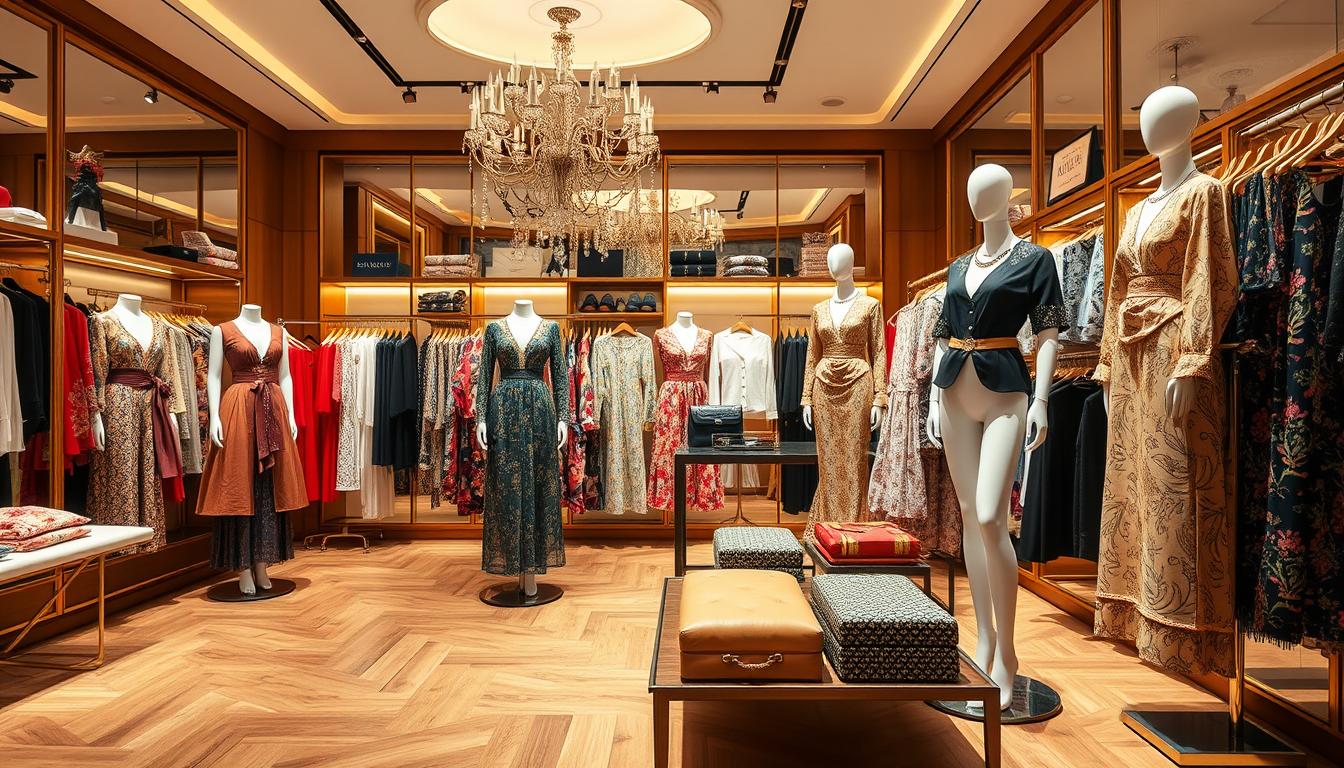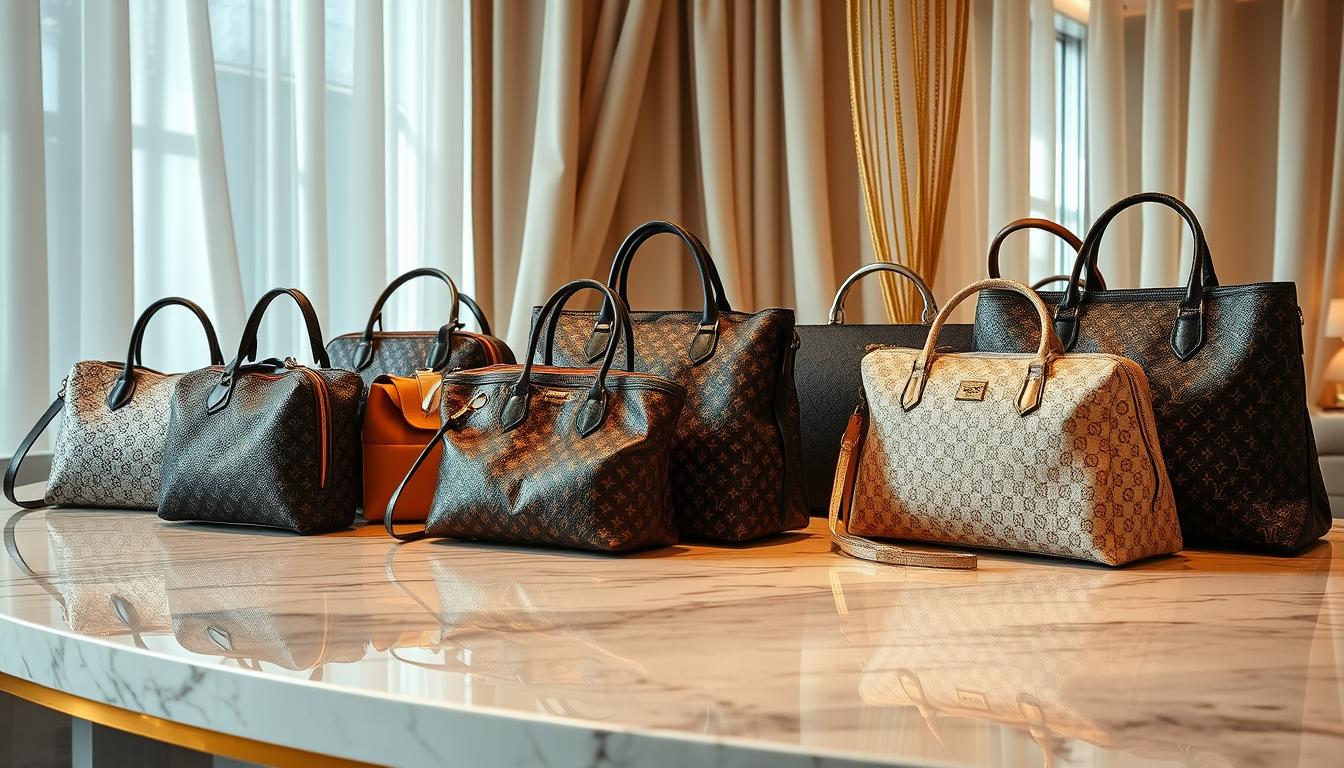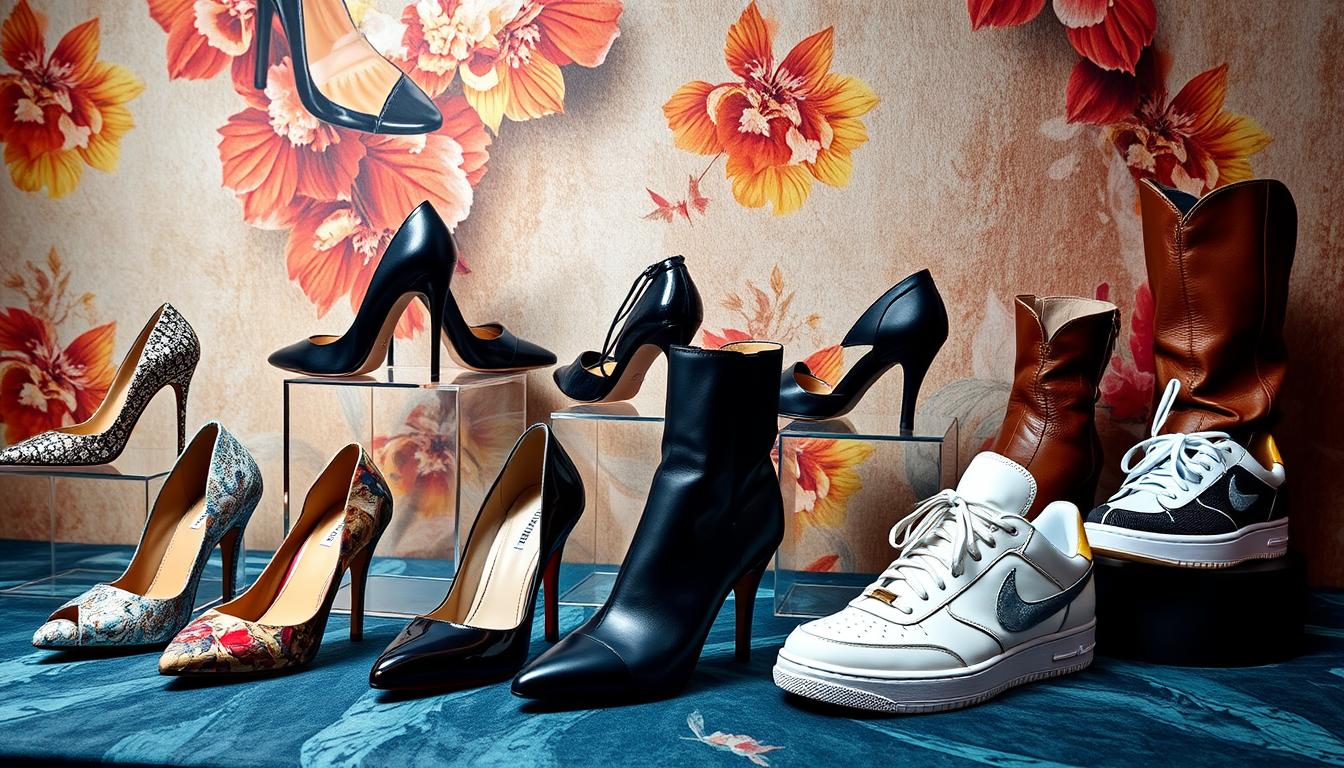The world of fashion is always changing, and the luxury market is growing fast. It’s now worth over $1.3 trillion globally as of 2022. Top brands like Chanel, Louis Vuitton, and Cartier lead this market. They are known for their exclusivity, quality, and prestige.
These brands make billions of dollars every year. They top the list of most valuable brands. They’ve also shaped our culture and ideas about luxury. Brands like Chanel and Hermès are setting the bar high in the luxury fashion world.
Key Takeaways
- The luxury goods market is estimated to be worth over $1.3 trillion globally as of 2022.
- Top luxury brands drive multi-billion dollar valuations and sales revenues each year.
- Iconic luxury fashion labels like Chanel, Louis Vuitton, and Cartier have become synonymous with exclusivity and quality craftsmanship.
- These premium clothing lines have greatly influenced popular culture and social ideas around luxury consumption.
- The most eminent luxury houses continue to set the standard for the luxury fashion industry.
Understanding Luxury Fashion: A Comprehensive Overview
Luxury fashion is all about top-notch craftsmanship, timeless style, and unmatched quality. These haute couture brands, upscale garment makers, and high-end fashion houses win over the hearts and wallets of those who value the best. They offer more than just clothes and accessories; they provide experiences that last a lifetime.
What Defines a Luxury Brand?
Luxury brands stand out by offering top products and services to the wealthy. They are known for their high prices, limited editions, and use of the finest materials. They focus on every detail, have strong brands, and a long history.
These brands work with famous designers, team up with celebrities, and provide outstanding service. This all adds up to a unique experience for their customers.
The Evolution of High-End Fashion
The luxury fashion world has grown fast, with sales doubling in recent years. It’s now one of the fastest-growing markets. Over time, what makes something luxurious has changed, leading to new trends.
The industry is getting smaller as brands merge and buy each other. This shows a trend towards bigger companies in the luxury market.
The Impact of Heritage in Luxury Markets
The history and legacy of luxury brands are key to their success. Brands with a long history and strong traditions are often more valuable. People want to buy from brands that are authentic and prestigious.
The creative leaders of these haute couture brands shape their identity and drive new ideas in the industry.
“Luxury is not about price, but about a certain quality and heritage.” – Bain & Company
The Power of Chanel in Modern Luxury Fashion
Chanel, the famous French fashion house, was founded by Coco Chanel. It’s known for timeless elegance and exclusivity. The brand has changed luxury fashion, winning hearts across many generations.
Karl Lagerfeld led Chanel from 1983 until his death in 2019. He mixed the brand’s heritage with new designs. This kept Chanel at the top of luxury fashion. The CC logo and tweed outfits are now symbols of Chanel’s greatness.
Chanel’s success today comes from its focus on exclusivity and value. In 2022, it made $17.22 billion, showing its global appeal. The Chanel No. 5 perfume and diverse products, like Rouge Coco lipstick, keep Chanel leading in fashion and beauty.
Chanel is big on social media, with over 60 million Instagram followers. It uses this to connect with people worldwide. Celebrities like Diane Kruger and Emma Watson help make Chanel famous.
Chanel keeps growing by staying true to its heritage and quality. Its fashion shows and wide range of products inspire many. This shows Chanel’s lasting impact on luxury fashion.
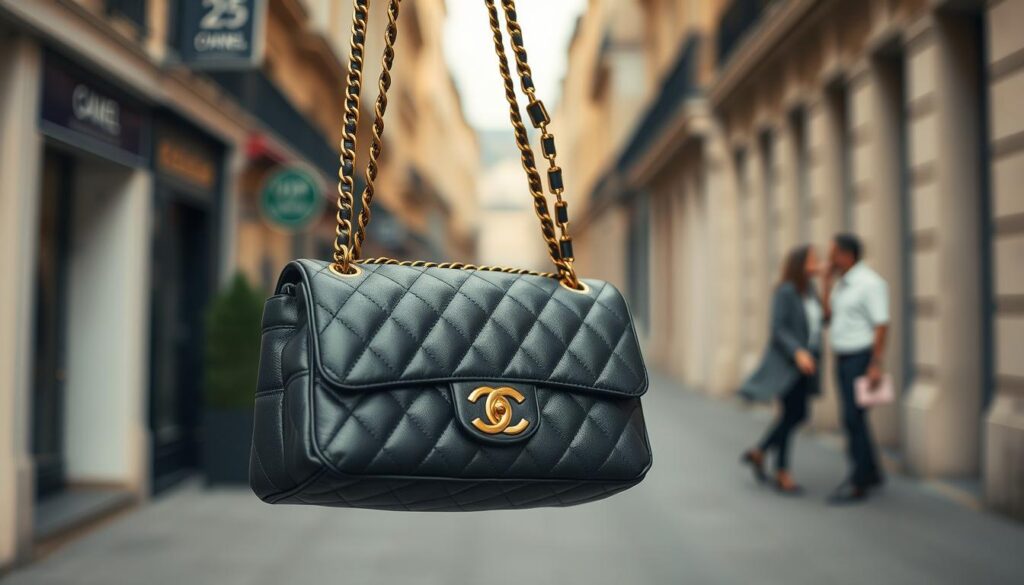
“Chanel is an institution, and institution’s don’t go out of fashion.”
– Coco Chanel
Louis Vuitton: Leading the Global Luxury Market
Louis Vuitton is a top name in the LVMH group, known for its iconic designs and luxury. In 2023, its brand value hit $124.8 billion, a 0.4% increase from the year before. This makes Louis Vuitton the most valuable luxury brand globally.
LVMH’s Market Dominance
Louis Vuitton’s success is linked to LVMH’s market lead. LVMH is the biggest luxury company in the world. It has a market value of $459 billion and made €86.2 billion in revenue in the last year. The company also made a net income of €15.2 billion.
Signature Products and Collections
Louis Vuitton’s designs have stood the test of time for over 167 years. Its monogram canvas and Damier pattern are instantly recognizable. These designs attract both long-time fans and new luxury lovers.
Marketing Strategies and Brand Positioning
Louis Vuitton stays ahead by mixing tradition with innovation in marketing. It has entered the streetwear scene, appealing to younger people with limited-edition items. The brand also partners with Asian celebrities to boost its global image.
Even with the COVID-19 pandemic, Louis Vuitton saw its revenue grow in the third quarter of 2020. This shows the brand’s ability to adapt and succeed in the ever-changing luxury world. It solidifies Louis Vuitton’s role as a global luxury market leader.
Gucci’s Revolutionary Approach to High-End Fashion
Gucci, the iconic Italian luxury brand, has been a leader in high-end fashion since 1912. It started in Florence as a maker of fine leather goods. Now, it’s a global powerhouse, loved by fashion fans everywhere.
Gucci is known for its commitment to transparency. It scored 48% in the Fashion Transparency Index, up from 40% in 2019. The brand got a perfect 100% in Policy and Commitments, showing its focus on sustainability and ethics.
Gucci is also great at staying relevant and connecting with its audience. It has over 3 million followers on Instagram. Through smart marketing and collaborations, it attracts Gen Z and millennials, who will soon make up 40% of the luxury market.
For example, Gucci teamed up with Post Malone, the American singer-songwriter. Their collaboration with Crocs got over 2.5 billion views. This shows Gucci’s knack for tapping into trends and reaching young people.
Gucci’s approach to fashion goes beyond products and marketing. Its commitment to innovation and creativity drives its success. Designs like the Gucci bamboo bag and The Jackie suitcase are symbols of luxury and style.
As the luxury market changes, Gucci stays ahead. It blends its heritage with a modern mindset. By being open, using digital platforms, and staying innovative, Gucci leads the high-end fashion world.
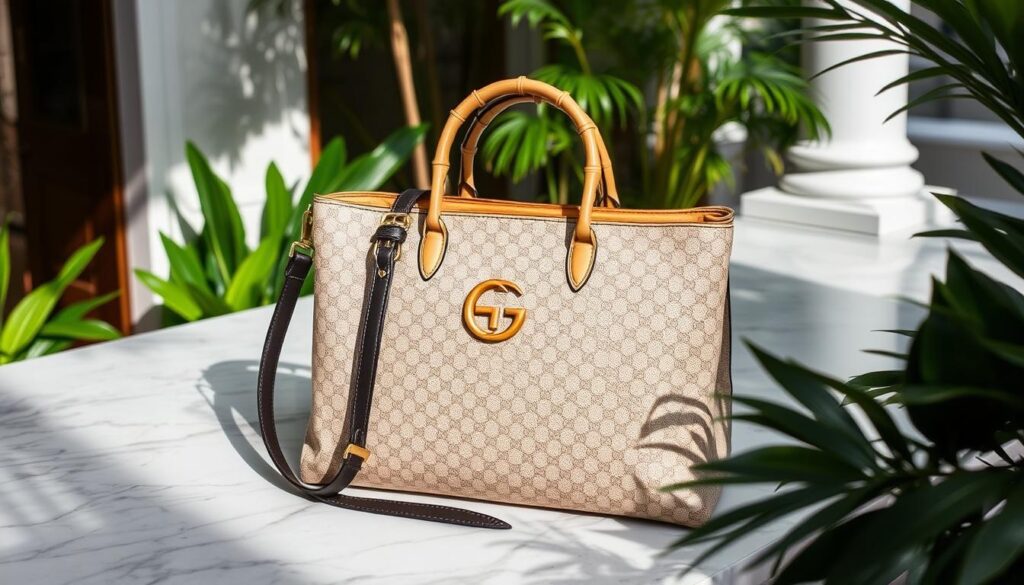
The Legacy of Christian Dior
Christian Dior changed fashion forever with his “New Look” collection in 1947. His designs, using up to 20 yards of fabric, reshaped women’s fashion. Dior quickly became a leader, opening his first U.S. store on New York’s Fifth Avenue in 1949.
Revolutionary New Look Collection
The “New Look” collection was a turning point for Dior. It set new standards for elegance and sophistication. The “H-Line” and “A-Line” silhouettes became symbols of Dior, influencing many designers to come.
Modern Brand Evolution
Many visionary leaders have kept Dior’s legacy alive. Yves Saint Laurent, John Galliano, Raf Simons, and Maria Grazia Chiuri have all made their mark. They’ve kept Dior fresh and relevant, even as fashion changes.
Digital Innovation and Global Reach
Dior is now a big name on social media, with over 45 million Instagram followers. Its beauty line is a big hit, known for quality and unique packaging. Dior’s history is celebrated through exhibitions, solidifying its status as a fashion icon and luxury leader.
“Christian Dior’s ‘New Look’ collection redefined women’s fashion and established him as a true trailblazer in the industry.”
Top High-End Clothing Brands in the Digital Age
The luxury fashion world is changing fast. Top brands are using digital tools to stay ahead. They aim to sell more online, with luxury sales expected to hit 33% by 2030.
Acne Studios from Stockholm is a big name in luxury fashion. BODE has made a splash in American menswear since 2016. Marni was early to e-commerce, starting its virtual store in 2006.
Bottega Veneta is known for its leather work. Martine Rose won the 2023 Fashion Award for best British Menswear Designer. Lemaire is famous for its elegant, comfortable designs.
Jean-Paul Gaultier has grown his brand to include fragrances. Jacquemus attracts celebrities, showing its high-end appeal. These brands keep up with digital trends to stay exclusive and desirable.
| Brand | Product | Price |
|---|---|---|
| Paolina Russo | Patchwork Illusion Colorblock Tank | $725 |
| Paolina Russo | Warrior Space Dye Sweater Miniskirt | $160 |
| Paolina Russo | Sleeveless Bias Cut Minidress | $360 |
| Fidan Novruzova | Malvina Jacket | €1 |
| Fidan Novruzova | Emma Cardigan | $760 |
| Fidan Novruzova | Giada Shorts | €295 |
Top luxury brands are using digital tools to grow in e-commerce. This move helps them stay at the top of online luxury sales.
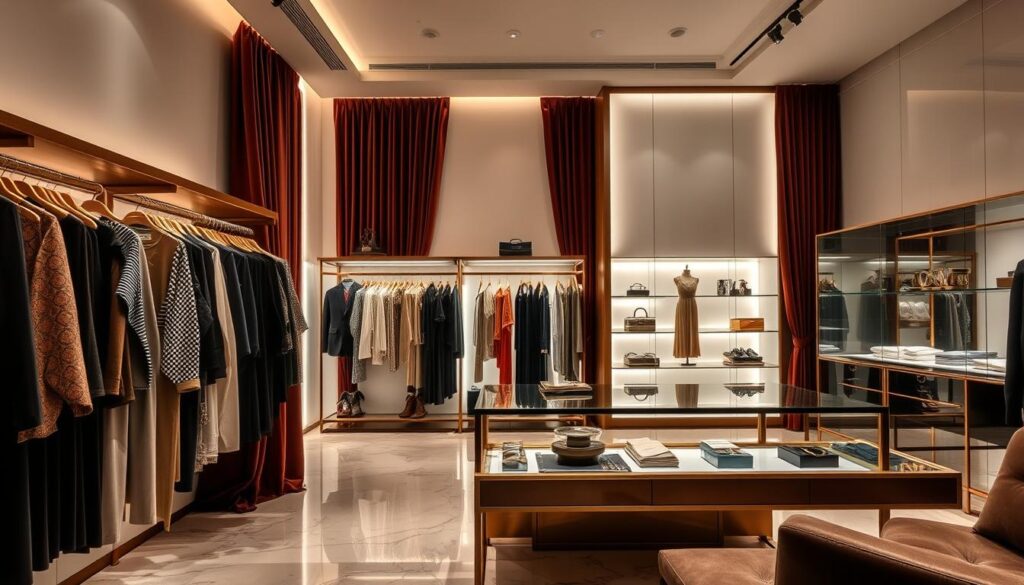
Hermès: The Epitome of Luxury Craftsmanship
Hermès is a top name in high-end fashion. It started in 1837 as a harness workshop in Paris. Today, it’s known worldwide for its luxury, innovation, and timeless style.
Iconic Bags and Accessories
Hermès is famous for its luxurious bags like the Birkin and Kelly. These bags are more than just accessories. They symbolize status and exclusivity, with prices that can go way up.
The brand uses special marketing tricks. It limits how many pieces it makes each year. This makes its products even more desirable.
Sustainable Innovation in Luxury
Hermès is also big on sustainability. It’s working with MycoWorks to make a leather alternative from mushrooms. This shows Hermès’ commitment to being green while keeping its high quality.
Hermès is all about craftsmanship, exclusivity, and being eco-friendly. It’s a leader in luxury fashion. Its Birkin bags, Kelly bags, and green efforts inspire many.
“Hermès is not just a brand, it’s a state of mind. It represents the pinnacle of luxury, craftsmanship, and exclusivity.”
Prada’s Journey from Leather Goods to Global Fashion Icon
Founded in 1913 by Mario Prada, the iconic Prada brand has grown into a global fashion leader. It started as a maker of high-quality leather goods. But under Miuccia Prada’s leadership, it became a top name in the luxury retail market.
Miuccia Prada joined the family business in the mid-1970s. She introduced Prada’s first footwear collection in 1979. The brand’s first fall/winter collection in 1988 was a huge hit, showing off its unique style and Italian craftsmanship.
Prada’s success is impressive. Sales jumped from $31.7 million in 1990 to $2.9 billion by 2010. The brand expanded with Miu Miu in 1993 and investments in Fendi.
| Year | Prada Sales |
|---|---|
| 1990 | $31.7 million |
| 2010 | $2.9 billion |
Prada also focuses on sustainability. It launched eco-friendly Prada handbags from recycled nylon. The Fondazione Prada, started in 1993, is a center for contemporary art and culture.
Now, Prada has 265 stores in 85 countries. Its products, from clothes to accessories, are known for their timeless style and innovation. Prada’s journey shows the impact of Italian craftsmanship and visionary leadership.
Saint Laurent’s Influence on Contemporary Fashion
Yves Saint Laurent, the visionary behind Saint Laurent, has made a lasting impact on fashion. He was known for his bold, gender-bending designs. These designs have redefined luxury apparel.
Revolutionary Design Philosophy
Yves Saint Laurent focused on mixing masculine and feminine styles. His Le Smoking Tuxedo suit, introduced in 1966, was a key part of this. It allowed women to wear a more androgynous look.
He also worked with artists like Andy Warhol and Piet Mondrian. They brought bold, graphic prints and avant-garde elements to his ready-to-wear clothing.
Modern Brand Evolution
Since its start, Saint Laurent has always pushed fashion boundaries. Its marketing campaigns are known for being edgy and provocative. This appeals to a wide range of fashion lovers.
In recent years, Saint Laurent has grown its product range. It now offers fragrances, cosmetics, and accessories. This move has made it a global luxury leader.
Today, Saint Laurent is a favorite among celebrities and fashion influencers. They love its gender-bending designs and commitment to innovation. As fashion changes, Saint Laurent continues to lead with its creative vision.
Balenciaga: Bridging Heritage and Innovation
Balenciaga, founded in 1917 by Cristóbal Balenciaga, is known for its haute couture and mix of old and new. Demna leads the brand, pushing luxury fashion to new heights. His bold vision excites the fashion world.
The brand’s 52nd Haute Couture collection, under Demna, showed its commitment to dressmaking. It moved away from the usual grandeur, focusing on clean lines and detail. This showcased Balenciaga’s skill in tailoring.
The collection included unique designs like slim tuxedos and puffer jackets. It also honored the brand’s past, recreating 1960s pieces. This blend of old and new was a highlight.
Demna used 3D printing for a Joan of Arc gown, mixing tradition with innovation. This move solidified Balenciaga’s role in modern fashion. It sets the standard for luxury and innovation.
| Balenciaga Key Facts | Details |
|---|---|
| Haute Couture Atelier Opening | Balenciaga opened its Haute Couture atelier in San Sebastián, Spain in 1917. |
| Balenciaga’s Establishment in Paris | The house of Balenciaga was established in Paris in 1937. |
| Cristóbal Balenciaga’s Retirement | Cristóbal Balenciaga presented his last collection in 1968 before retiring. |
| Brand Acquisition and Relaunch | Balenciaga was acquired by Jacques Bogart S.A. in 1986, and the brand’s first ready-to-wear line, Le Dix, was opened that same year. |
| Kering’s Acquisition | Kering acquired Balenciaga in 2001, leading to the brand’s continued growth and success. |
| Creative Directors | Nicolas Ghesquière was the Creative Director of Balenciaga until 2012, followed by Alexander Wang and then Demna, who presented the brand’s first Haute Couture collection in 2021 after a 53-year hiatus. |
Balenciaga’s journey is marked by its dedication to haute couture techniques. It has become a leader in contemporary fashion. The brand’s mix of heritage and innovative designs inspires and captivates people everywhere.
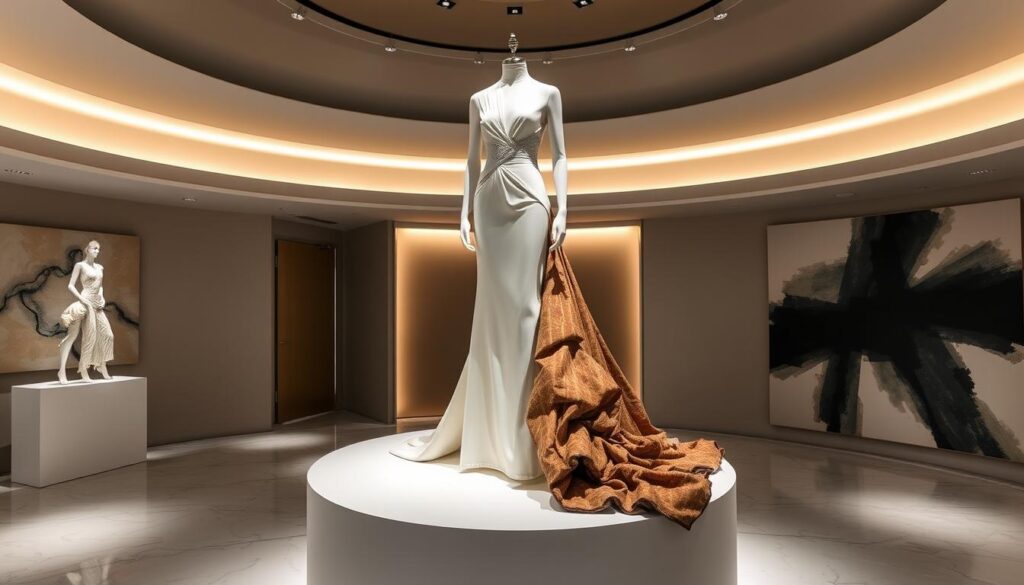
The Future of Luxury Fashion Marketing
The luxury fashion world is changing fast, thanks to digital technology. This shift is making it easier for brands to connect with their high-end customers. Now, digital marketing and social media are key for luxury brands to stay unique and attract young, wealthy buyers.
Digital Transformation in Luxury Retail
Luxury fashion brands are now using online stores, virtual try-ons, and augmented reality (AR). These tools make shopping more convenient and personal. They also add a touch of exclusivity that today’s luxury shoppers love.
Emerging Market Trends
- Sustainability: Luxury brands are adding eco-friendly practices, like circular textiles and digital product passports. This meets the growing need for green fashion.
- Personalization: Made-to-order and customized items are becoming popular. Luxury shoppers want unique, tailored products.
- Experiential Retail: Luxury brands are creating immersive shopping experiences. These experiences help build stronger connections with customers.
As the luxury fashion world changes, brands must find a balance. They need to keep their exclusive charm while meeting new consumer demands. By embracing digital, social media, and new trends, luxury brands can stay ahead in the fast-paced market.
“Luxury brands that successfully integrate digital innovation, sustainability, and personalization will thrive in the evolving luxury fashion landscape.”
Conclusion
The luxury fashion world is always changing. Top brands are now using digital tools and listening to what customers want. Brands like Chanel, Dior, and Gucci stay popular by mixing old traditions with new ideas.
New trends like green fashion, online marketing, and making things just for you are big. These changes are shaping what luxury fashion will be like in the future.
Brands face a big challenge: keeping things special while reaching out to more people. Luxury streetwear, like Off-White and Yeezy, is changing the game. It mixes fancy fashion with street style.
More people want to buy things that are good for the planet. This shows that customers care about the environment when they shop.
The future of luxury fashion is exciting but tricky. Brands must keep their roots while meeting new customer needs. Using digital tools, being green, and making things personal are key.
This way, top brands can stay ahead in the fast-changing world of luxury fashion.
FAQ
What is the current size of the global luxury goods market?
FAQ
What is the current size of the global luxury goods market?
The luxury goods market is worth over
FAQ
What is the current size of the global luxury goods market?
The luxury goods market is worth over $1.3 trillion globally as of 2022.
What are the characteristics of luxury brands?
Luxury brands are known for their high prices and limited production. They use premium materials and focus on detail. They also have iconic branding and a long history.
They often partner with celebrities and provide exceptional customer service.
How has Chanel influenced modern luxury fashion?
Chanel, founded by Coco Chanel, changed women’s fashion with designs like the little black dress. They also created Chanel No. 5 perfume and the 2.55 bag.
Karl Lagerfeld modernized Chanel’s designs in the ’80s. This included the famous interlocking CC logo, helping the brand stay successful.
What factors have contributed to Louis Vuitton’s dominance in the luxury market?
Louis Vuitton’s success comes from its iconic designs, unchanged for 167 years. They’ve also entered the streetwear market and done limited-stock drops.
They’ve partnered with Asian celebrities and expanded into new markets.
How has Gucci’s brand image evolved over time?
Gucci started with luxury bags but began making clothing in 1968. Tom Ford’s transformation in 1994 made it a top brand globally.
Today, Gucci is loved by Gen Z and millennials. They’re expected to make up 40% of the luxury market by 2035.
What is the legacy of Christian Dior in the fashion industry?
Christian Dior’s “New Look” collection changed fashion in the 1940s and 1950s. Dior shows off its history and heritage through exhibitions.
Its beauty line is a big part of its success.
How are luxury brands adapting to digital transformation?
Luxury brands are investing in e-commerce and virtual try-on experiences. They use social media and partner with influencers to reach younger consumers.
What makes Hermès a unique luxury brand?
Hermès is famous for its exclusive bags like the Birkin and Kelly. These bags can sell for ten times the value of gold.
The brand uses word-of-mouth and exclusivity in its marketing. It’s also working with MycoWorks to create sustainable leather from mushrooms.
How has Prada’s brand identity evolved over time?
Prada was founded in 1913 by Mario Prada. It became well-known in the 1980s under Miuccia Prada’s leadership.
Prada is a big player in the luxury retail market. It’s also focused on reducing its carbon footprint and promoting eco-friendly practices.
What is the legacy of Saint Laurent in the fashion industry?
Saint Laurent, founded by Yves Saint Laurent, changed fashion with gender-bending designs. The brand is famous for its “Le Smoking” Tuxedo suit.
It has also collaborated with artists. Saint Laurent continues to be bold with its marketing campaigns.
How does Balenciaga’s approach to luxury fashion stand out?
Balenciaga, founded in 1917, combines traditional haute couture with modern styles. It offers a bold, contemporary take on luxury fashion.
It’s known for oversized silhouettes, striking colors, and high-profile collaborations.
.3 trillion globally as of 2022.
What are the characteristics of luxury brands?
Luxury brands are known for their high prices and limited production. They use premium materials and focus on detail. They also have iconic branding and a long history.
They often partner with celebrities and provide exceptional customer service.
How has Chanel influenced modern luxury fashion?
Chanel, founded by Coco Chanel, changed women’s fashion with designs like the little black dress. They also created Chanel No. 5 perfume and the 2.55 bag.
Karl Lagerfeld modernized Chanel’s designs in the ’80s. This included the famous interlocking CC logo, helping the brand stay successful.
What factors have contributed to Louis Vuitton’s dominance in the luxury market?
Louis Vuitton’s success comes from its iconic designs, unchanged for 167 years. They’ve also entered the streetwear market and done limited-stock drops.
They’ve partnered with Asian celebrities and expanded into new markets.
How has Gucci’s brand image evolved over time?
Gucci started with luxury bags but began making clothing in 1968. Tom Ford’s transformation in 1994 made it a top brand globally.
Today, Gucci is loved by Gen Z and millennials. They’re expected to make up 40% of the luxury market by 2035.
What is the legacy of Christian Dior in the fashion industry?
Christian Dior’s “New Look” collection changed fashion in the 1940s and 1950s. Dior shows off its history and heritage through exhibitions.
Its beauty line is a big part of its success.
How are luxury brands adapting to digital transformation?
Luxury brands are investing in e-commerce and virtual try-on experiences. They use social media and partner with influencers to reach younger consumers.
What makes Hermès a unique luxury brand?
Hermès is famous for its exclusive bags like the Birkin and Kelly. These bags can sell for ten times the value of gold.
The brand uses word-of-mouth and exclusivity in its marketing. It’s also working with MycoWorks to create sustainable leather from mushrooms.
How has Prada’s brand identity evolved over time?
Prada was founded in 1913 by Mario Prada. It became well-known in the 1980s under Miuccia Prada’s leadership.
Prada is a big player in the luxury retail market. It’s also focused on reducing its carbon footprint and promoting eco-friendly practices.
What is the legacy of Saint Laurent in the fashion industry?
Saint Laurent, founded by Yves Saint Laurent, changed fashion with gender-bending designs. The brand is famous for its “Le Smoking” Tuxedo suit.
It has also collaborated with artists. Saint Laurent continues to be bold with its marketing campaigns.
How does Balenciaga’s approach to luxury fashion stand out?
Balenciaga, founded in 1917, combines traditional haute couture with modern styles. It offers a bold, contemporary take on luxury fashion.
It’s known for oversized silhouettes, striking colors, and high-profile collaborations.

